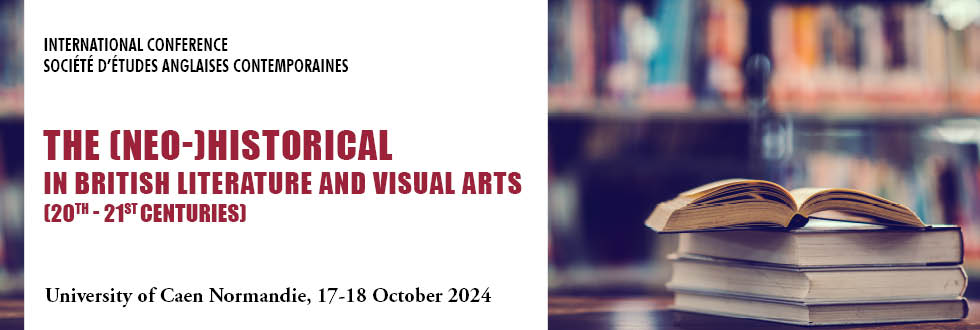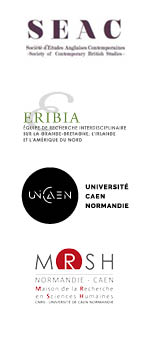
|
Call for papers SEAC International Conference Université de Caen Normandie, 17-18 October 2024 Organized by Armelle Parey
Special guest: Lucy Caldwell, winner of the 2023 Walter Scott Prize for historical fiction.Confirmed keynote speakers: Jerome de Groot (University of Manchester) and Diana Wallace (University of South Wales). In his overview of the historical novel 1980-2018, Jerome de Groot states: ‘It could be argued that the British historical novel is the most important, influential and enduring literary genre of the last thirty-five years’ (de Groot 2019, 169) – seemingly forever attracting more writers as is the case with Zadie Smith and her latest The Fraud (2023) advertised by Penguin as her first historical novel. The genre also enjoys large visibility in popular culture: as pointed out by Leigh Wilson, historical fiction now ‘wins literary prizes, is the primary choice of book clubs, dominates bestseller lists and is snapped up for film and TV adaptations’ (Leigh Wilson 145). Indeed, besides the Walter Scott Prize created in 2009 and dedicated to historical fiction, the list of Booker prizewinners since the 1990s clearly reflects this prevailing interest in the past. Commercially successful, contemporary historical fiction, whether it considers historical events or focuses on social history, is regularly adapted for the screen where it features along with no less popular period drama. The genre has however undergone many changes and variations since its early instances in the 18th and 19thcenturies and now takes on a great variety of guises. Robert Eaglestone thus points out “the ever more diverse and contradictory array of modes by which the past is represented, forms which far exceed the historical novel as usually conceived” (2019, 312). This renewal of interest in the past and in ways of telling it is not only obvious in the significant number of scholarly studies published in the 2000s1 but also in the advent of neo-Victorian fiction whose early proponents may be considered to be Jean Rhys and John Fowles but which has developed more extensively since the 1990s, notably with A.S. Byatt’s Possession (1990). For Ann Heilmann and Mark Llewellyn, what is remarkable in this trend is, at least at first, its self-conscious reconstruction of memory expressed in the “neo” prefix: ‘texts (literary, filmic, audio/visual) must in some respect be self-consciously engaged with the act of (re)interpretation, (re)discovery and (re)vision concerning the Victorians’ (2010, p. 4, emphasis in the original). It is this very “self-analytic drive”, this interrogation of the past that Elodie Rousselot offered to discuss in novels portraying other eras, coining the composite word ‘neo-historical’ forwhat she sees as a ‘sub-genre of contemporary historical fiction […] characterized by its similar creative and critical engagement with the cultural mores of the period it revisits” (Rousselot 2). If the early neo-Victorian works were historiographic metafictions, some of its later instances, like neo-historical works, can be considered as post-postmodern insofar as they retain a form of self- consciousness from postmodernism but nevertheless “strive[s] for a high degree of accuracy” (Rousselot 4) in their representations. Similarly, Peter Boxall points to a return to ‘a fresh commitment to what we might call the reality of history’ (Boxall 41) in contemporary representations of the past marked by the ‘struggle towards a historical realism that remains beyond the grasp of a narrative that is alive to its own limitations’ (Boxall 64). As Katherine Harris puts it, “The neo- historical aesthetic acknowledges the inevitable failure of narratives about the past but […] simultaneously and contradictorily works to create coherent stories about it that recognize their own limitations even as they attempt to overcome them” (Harris 194). The contradiction between the novelty suggested by “neo” and the past in “historical” (Rousselot 3) conveys this paradox of the neo-historical. Yet, just as the neo-Victorian abandoned the self-conscious dimension to become, for instance in Sarah Waters’ Affinity (1999), what Kate Mitchell calls “faux-Victorian fiction; novels written in the Victorian tradition that refuse to self-reflexively mark their difference from it in the characteristically parodic mode of historiographic metafiction” (Mitchell 117), the neo-historical tones down its disruptive manner when problematizing historical representation. In Carmen Perez Riu’s words, it still “revises history but avoids experimentation and other radical or postmodern formal gestures” (Perez Riu 187) – to the extent that “critical engagement with that past may appear to be absent, while it is in fact seamlessly embedded in the text (Rousselot 5). On the other hand, some contemporary representations of history do “use more radical disruptions of narrative realism […] to offer an authentic critique of Britain’s past” (Bentley 107): examples can be found in works by Kate Atkinson, David Pearce and Jan Carson. In the first case, when the new approach is seamless, the term “neo-historical”, with its prefix that implies difference from what existed previously, may be problematic. Neo-historical fictions, according to Rousselot, enable a re-appraisal of cultural events, themes and characters, and they do so by “push[ing] beyond what we know or think is ‘true’ about the past in order to invent new histories” (Harris 197). In doing so, they grant visibility to previously ignored aspects, such as herstory, but also address concerns of our times. This may translate into what Harris considers a key-characteristic of neo-historical fiction: “conspicuous use of anachronisms: language, politics and images that are manifestly the product of the period in which the novels are written” (Harris 194), when “a word, phrase or image that is demonstrably incongruent in its setting […] has a particular meaning in the present that is relevant to the moment of writing rather than the past in which the novel is set” (Harris 199). These words and images are thus a marker of the presence of the present in the narrative of the past. Paradoxically, anachronism may convey authenticity in the sense that it goes against the traditional record of the era with the aim of giving a broader picture of a period when including or focusing on, for instance, homosexuals or servants. For Harris, however, drawing on Marie-Luise Kohlke’s work, “anachronistically imposing present-day ideologies onto the past positions the present as superior to the past” (Harris 208) and neo-historical fiction ultimately “permits a self-congratulatory politics about history in general” (Harris 210). Looking at a similar return to the past in American letters, Ina Bergman notes that “new Historical fiction” bridges “the gap between supposedly serious and popular literatures” whereas until recently the historical novel “bore the stigma of genre fiction” (Bergmann 140). Genre is often associated with gender when considering representations of the past in fiction and visual arts. While analyses and accounts such as Georg Lukacs’s and Perry Anderson’s anchor and value historical fiction as a male genre starting with Walter Scott (see Sutherland 20), Kate Atkinson laments: “you do have to write about the war in order to be taken seriously” (Tolan 5). Both Diana Wallace and Kathlyn Sutherland have argued and showed that historical fiction existed before Scott and never disappeared – in fact, “From the 1920s to the 1970s, the historical novel flourished in Britain in the hands of women writers” (Sutherland 18) – but women's novels were excluded from discussions of the genre until recently.2 Until Pat Barker and Hilary Mantel, historical fiction by women tended to be dismissed as historical romance as exemplified by Georgette Heyer’s works but for Diana Wallace, following in the footsteps of Alison Light, “As a form […] women’s historical fiction encompasses the radical and the conservative, popular and literary” (Wallace 2012, 208). Wallace’s plea for “ways of reading women’s historical fictions that will allow us to recognize their difference from what has traditionally been regarded as ‘proper history’ and the ‘classical historical novel’ and to value that difference rather than dismissing it as ‘tosh’” (Wallace 2012, 217) could be addressed in this conference. Ten years after Rousselot’s use of the term “neo-historical” in her edited collection, this conference will give an opportunity to discuss and question aspects and limits of this sub-genre and figure out to what extent it addresses issues of the present, such as (sexual) identities or the environment. The theme of this conference also invites us to take the long view and consider earlier as well as alternative approaches to the past. Possible topics or issues to explore (alone or combined) the field of the neo-historical include but are not limited to: - Authenticity - Biofictional narratives - Ethics of representation - Experimentalism - Genre and gender - Genre fiction - Nostalgia - Presentism and the role of anachronism - The commodification of history - Modernist and anti-Modernist precedents
Papers (in English only) will focus on British literature and visual arts of the 20th and the 21st centuries.
This conference will be convened by Armelle Parey. It will be held at the Maison de la Recherche en Sciences Humaines, Université de Caen Normandie, on October 17th and 18th, 2024. Proposals of 300 words, together with a short biographical note, should be sent to Armelle Parey (armelle.parey@unicaen.fr) by April 30th, 2024. Notifications of acceptance will be sent by June 1st, 2024. A selection of peer-reviewed papers will be published in the SEAC’s journal Études britanniques contemporaines: https://journals.openedition.org/ebc/
------- 1See Middleton and Woods (2000), Keen (2006 ‘Historical’), Boccardi (2009), De Groot (2010), Robinson (2011). 2 “the historical novel did not become a ‘recessive form’ after the First World War as Anderson claims. Instead it became, in Britain at least, a predominantly female form. Writers as disparate as Naomi Mitchison, Rose Macaulay, Georgette Heyer, Sylvia Townsend Warner, Bryher, Hilda Vaughan, Kate O’Brien, D.K. Broster, H.F.M. Prescott, Rosemary Sutcliff, Mary Renault and Jean Rhys reinvented the genre in radical ways” (Wallace 2011). |
Partners
|


